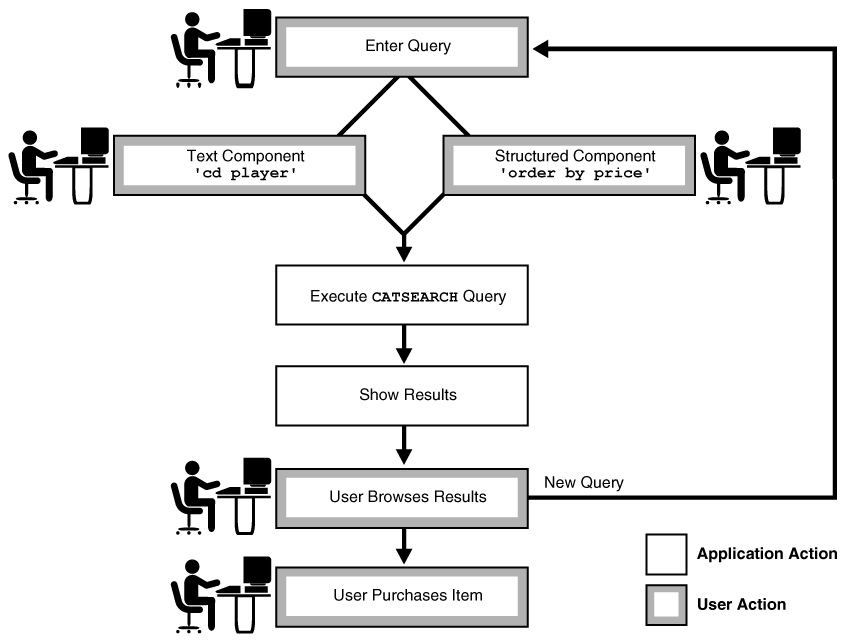1.3 Catalog Information Applications
Catalog information consists of inventory type information, such as for an online book store or auction site.
This section contains the following topics.
1.3.1 About Catalog Information Applications
The stored catalog information consists of text information, such as book titles, and related structured information, such as price. The information is usually updated regularly to keep the online catalog up-to-date with the inventory.
Queries are usually a combination of a text component and a structured component. Results are almost always sorted by a structured component, such as date or price. Good response time is always an important factor with this type of query application.
Catalog applications are best served by a CTXCAT index. Query this index with the CATSEARCH operator in the WHERE clause of a SELECT statement.
Figure 1-3 illustrates the relationship of the catalog table, its CTXCAT index, and the catalog application that uses the CATSEARCH operator to query the index.
Note:
The Oracle Text indextypeCTXCAT is deprecated with Oracle Database 23ai. The indextype itself, and it's operator CTXCAT, can be removed in a future release.Both CTXCAT and the use of CTXCAT grammar as an alternative grammar for CONTEXT queries is deprecated. Instead, Oracle recommends that you use the CONTEXT indextype, which can provide all the same functionality, except that it is not transactional. Near-transactional behavior in CONTEXT can be achieved by using SYNC(ON COMMIT) or, preferably, SYNC(EVERY [time-period]) with a short time period.
CTXCAT was introduced when indexes were typically a few megabytes in size. Modern, large indexes, can be difficult to manage with CTXCAT. The addition of index sets to CTXCAT can be achieved more effectively by the use of FILTER BY and ORDER BY columns, or SDATA, or both, in the CONTEXT indextype. CTXCAT is therefore rarely an appropriate choice. Oracle recommends that you choose the more efficient CONTEXT indextype.
1.3.2 Flowchart for Catalog Query Application
A catalog application enables users to search for specific items in catalogs. For example, an online store application enables users to search for and purchase items in inventory. Typically, the user query consists of a text component that searches across the textual descriptions plus some other ordering criteria, such as price or date.
Figure 1-4 illustrates the flowchart of a catalog query application for an online electronics store.
-
The user enters the query, consisting of a text component (for example, cd player) and a structured component (for example, order by price).
-
The application executes the
CATSEARCHquery. -
The application shows the results ordered accordingly.
-
The user browses the results.
-
The user enters another query or performs an action, such as purchasing the item.
Figure 1-4 Flowchart of a Catalog Query Application

Description of "Figure 1-4 Flowchart of a Catalog Query Application"
